I undertook a flying visit to Bratislava this last weekend on the 4th January. I am already looking forward to a return trip, perhaps as part of a three capital tour either by road or rail to take in Vienna and Budapest. Bratislava is 50 miles from Vienna and a two and a half hour drive from Budapest. I would do the train journey as it is cheap, comfortable and fast.
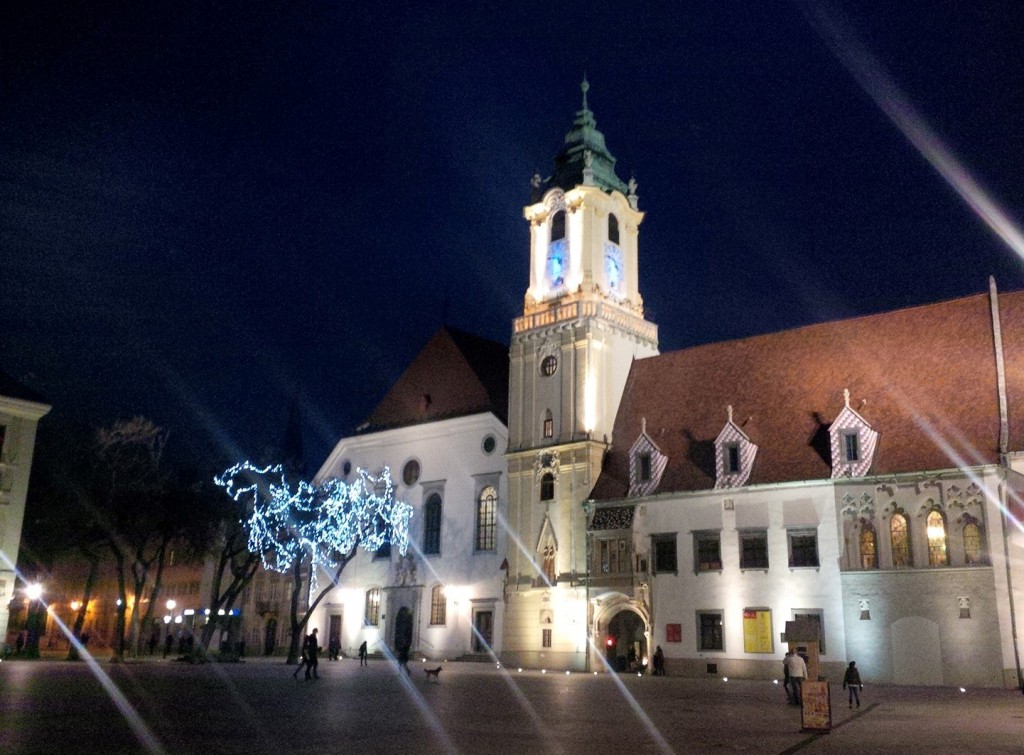
Bratislava is, like a lot of East European cities, a place of contrasts and mixed styles. The name itself was only really attached at the beginning of the 20th Century. In its time, the city has been called Istropolis; Pressburg; Pozsony; Presporok; and even for a brief period Wilsonstadt in honour of the U.S. President Woodrow Wilson who supported the cause of Slovak independence. In 1919, the name Bratislava was officially adopted and this city has come to be known as a jewel of the Danube with some less honourable mentions as a destination for stag nights.
The Slovak nation has fought for and finally achieved its status as an independent nation after its Velvet Divorce from its Czech neighbour in 1993. During its history, Bratislava has been a Celt settlement; part of the Roman Empire; an important city in the Principality of Nitra and Great Moravia; a free royal town in the Kingdom of Hungary; besieged by the Turks of the Ottoman Empire; the capital of Hungary from 1536; a coronation town and centre for development during the time of Queen Maria Theresa; captured by Austrians in 1848; incorporated into the new Czechoslovakia in 1919; the capital of a Nazi puppet state during the Second World War; subjugated by the Russians on the wrong side of the Iron Curtain; occupied by Warsaw Pact forces after the failed Czech revolution in 1968 and, finally, its own city in its own country. So this place has history!
And it has culture. All the greats played here: Mozart; Haydn; Beethoven; Liszt; they were even advertising a Katy Perry concert for February.
The architecture varies from ancient through Baroque to Art Nouveau and though the dual carriageway built through the city qualifies as a true monstrosity there are not too many examples of modern desecration. Indeed, the pedestrianized area of the main city is probably one of the most pleasant walks in Europe. Yes, it is a tourist city now and the restaurants and bars tend to cater to the passing visitor, but there are still nuggets of fascination which will certainly bring me back.
The main square is – as the name implies – where to start and the road system delivers you pretty close, with parking not too difficult – bear in mind that we were there on the first weekend of the year so other times might be more difficult. Ignore the kitsch Napoleonic soldier leaning on a bench and other twee elements of a fevered tourist chief’s imagination: just look around.
The old town hall with the Jesuit Church beside it. I like churches – I cannot forget all the souls that worshipped in them and they often have great art – and Bratislava has more than we could cover in an overnight stay. The Roland statue which is actual of Maximilian II; the 18th Century buildings and the Art Nouveau insurance building also housing a rather nice-looking Kaffee und Kuchen shop.
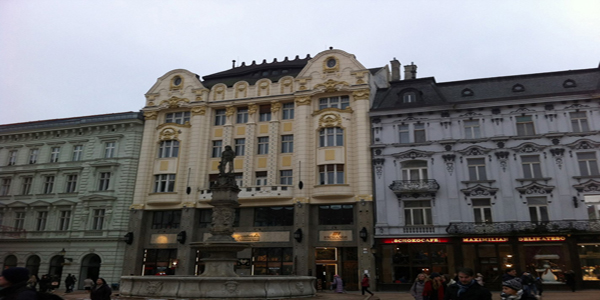
We had our coffee and indulgent cake in the Mayer café – just by the irrelevant statue – and it lived up its reputation for great cream cakes, which we enjoyed under the stern gaze of a moustachioed bust of someone that looked like Franz Joseph II. Lunch was just outside the pedestrianized area in a great beer and goulash restaurant called the town brewery. Dumplings; great chunks of meat and good portions of local beer.
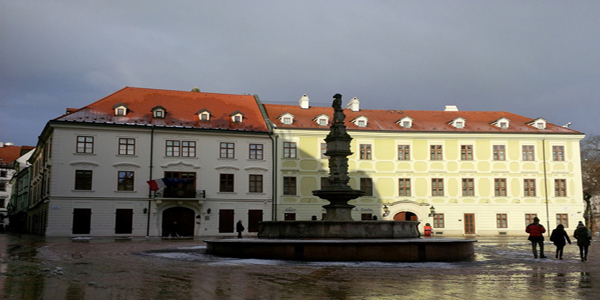
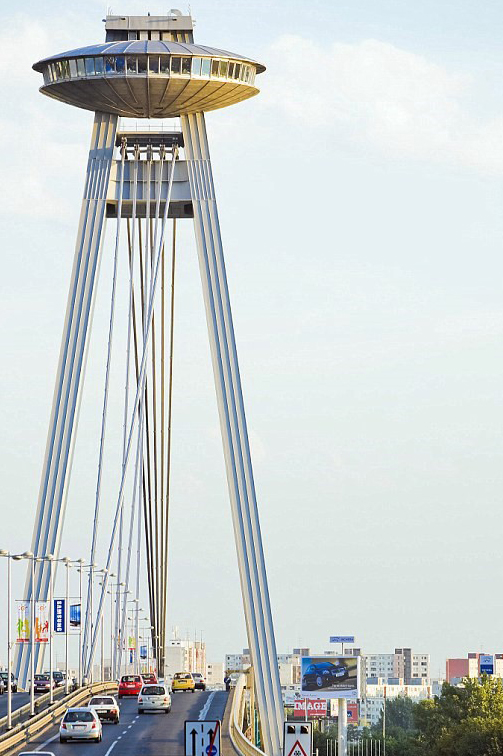
Bratislava is a great city for walking and it is easy to cover most of the main stops – apart from the hill-top castle on foot. Start at the Danube which Bratislava bestrides and work your way in. The afore-mentioned dual carriageway carries a bridge over the river and also includes the UFO Bridge with its restaurant at the top of the spaceship.
Go past the Old National theatre and head towards the main square. We were there while there were skaters on an admittedly small ice rink – Somerset house this is not – and the Christmas Tree was still erected.
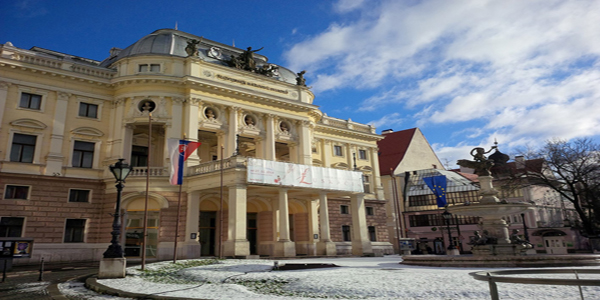
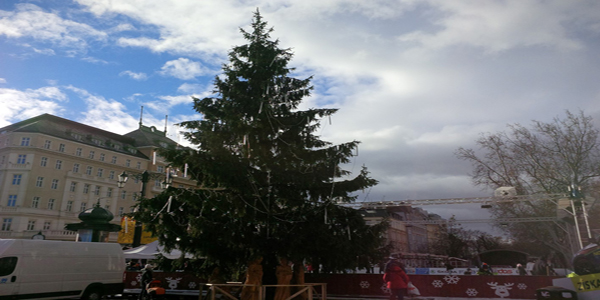
Past the main square you will glance the castle on the hill. This is worth a trip but jump a trolley bus to do it. Described by one unkind traveller as an upside down bedstead, it is still impressive and the history is worth reading. It was too big to fit on to one photo but I am sure you get the message.
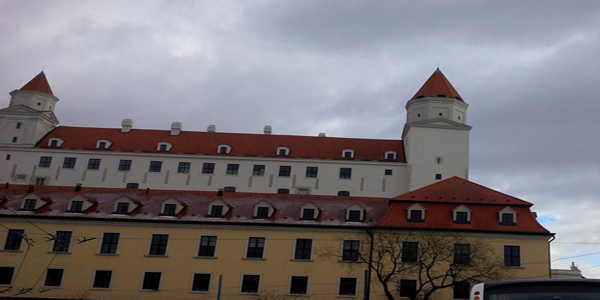
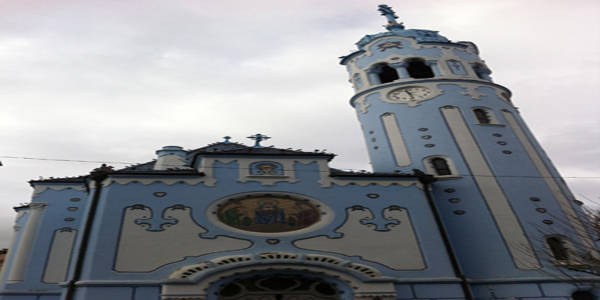
Keep walking and don’t be afraid to duck in and out of the fascinating little alleys that lead off all the main streets. The shops are aimed centrally at the tourist though the Slovak Art centre on the main square looks to have some genuinely good examples of local craftware.
Down one of these alleys, we found the Grand Cru Wine Gallery and it’s a great spot for a pre-prandial glass or two, though the snacks looked pretty good. Martin really loves his local wines and we tried four between the two of us with grape varieties we had never heard of such as alibernet, which originated in the Ukraine. The vineyards produce small parcels of three to six hundred bottles so this wonderful nectar does not get out of the country: drink it while you can.
For dinner, we scaled the road up the castle over the afore-mentioned dual carriageway – you may gather I really didn’t like this road – and found, on the recommendation of our hotel concierge, Modra Hviezda (Blue Star), a traditional restaurant with its main tables in a cellar; some great wine and traditional food such as rabbit; pork; goulash; etc. A two course dinner with foie gras; a glass of sauternes; a good bottle of blue Portuguese red wine and schnapps after ran to just on €100.
That is one disadvantage with Bratislava as opposed to its neighbour the Czech Republic, which uses its own koruna as a currency and, outside Prague, is definitely better value.
We stayed at the Hotel Skaritz which was good value, if somewhat noisy. If we could, we would have stayed at Marrol’s, which though a little bit off the track, also has a great restaurant called the Messina.
On Sunday before departure, we went a little way out of the centre – but still highly walkable – and visited the blue church, an amazing wedding cake of architecture with a fascinating history – just Google it.
Bratislava, we liked you and we will see you again.
If this blog entry inspired you, why not book your Eastern European city-break today!
Author: David Owen
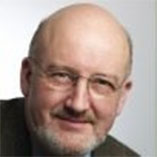
This entry was posted on Monday, January 12th, 2015 at 6:32 pm; on the subject of Eastern Europe, Slovakia.